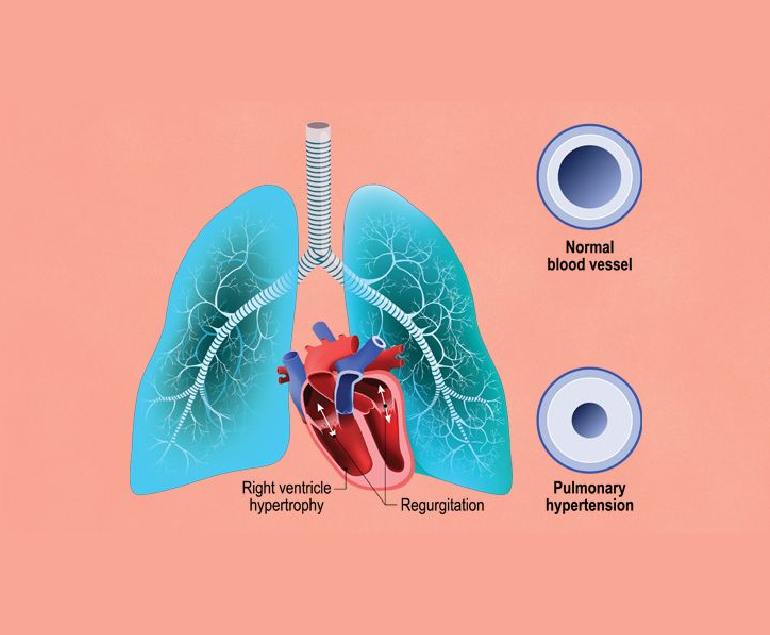Pulmonary hypertension (PH) is a rare, yet serious medical condition that affects the lungs and the heart. It is characterized by high blood pressure in the pulmonary arteries, which are the blood vessels responsible for carrying blood from the heart to the lungs for oxygenation. This increased pressure puts a strain on the heart and can lead to severe complications if left untreated. In this edition of Know Your Heart series, we will look into the causes, symptoms, diagnosis, and treatment options for pulmonary hypertension.
Causes of Pulmonary HypertensionPulmonary hypertension is classified into various types based on the underlying cause. The most common types are:
- Idiopathic Pulmonary Arterial Hypertension (IPAH): In this type, the exact cause remains unknown, but it is believed to be related to genetic factors or certain risk factors.
- Secondary Pulmonary Hypertension: This type is a result of an underlying medical condition such as chronic lung diseases (chronic obstructive pulmonary disease – COPD, interstitial lung disease), heart diseases, blood clot in the lungs, sleep apnea, etc.

- Pulmonary Hypertension due to Left Heart Disease: It occurs when the left side of the heart fails to efficiently pump blood, causing increased pressure in the pulmonary arteries.
- Chronic Thromboembolic Pulmonary Hypertension (CTEPH): CTEPH is a rare but potentially curable form of PH that results from blood clots in the lungs that fail to dissolve over time.
The symptoms of pulmonary hypertension can be subtle, leading to delayed diagnosis and treatment. Common symptoms include:
- Breathlessness: Especially during physical activity or while lying down.
- Fatigue: Feeling tired and weak even after minimal exertion.
- Chest pain: Experiencing chest discomfort or pressure.
- Racing heartbeat: Palpitations and irregular heartbeats may occur.
- Dizziness and fainting: Feeling lightheaded or passing out.
- Bluish lips and skin: Due to decreased oxygen levels in the blood.
Early diagnosis of pulmonary hypertension is crucial for effective management. If your doctor suspects PH, they may perform the following tests:
- Echocardiogram: This non-invasive test uses ultrasound to evaluate the heart’s structure and function, providing information on the pressures in the pulmonary arteries.
- Pulmonary Function Tests (PFTs): These tests assess lung function and help rule out underlying lung diseases.
- Right Heart Catheterization: Considered the gold standard for diagnosing PH, this procedure measures the pressures in the heart and lungs.
- CT Scan or Ventilation-Perfusion Scan: These imaging studies can detect blood clots or other lung conditions that may contribute to PH.
Treatment for pulmonary hypertension depends on the type, severity, and underlying cause. It aims to improve symptoms, slow down the progression of the disease, and enhance the patient’s quality of life. Treatment options include:
- Medications: Various medications, such as vasodilators, endothelin receptor antagonists, and phosphodiesterase-5 inhibitors, can help dilate blood vessels and reduce blood pressure in the lungs.
- Oxygen Therapy: Supplemental oxygen can improve oxygen level in the blood and reduce the symptoms.
- Lung Transplantation: In severe cases, where other treatments are ineffective, a lung transplant may be considered.
- Lifestyle Modifications: Engaging in regular exercise, maintaining a healthy diet, quitting smoking, and managing other health conditions can positively impact PH.
- Supportive Therapies: Pulmonary rehabilitation and counseling can provide support and improve the patient’s well-being.
As pulmonary hypertension is a serious condition, it requires early diagnosis and proper management. Early intervention can significantly improve outcomes and enhance the patient’s quality of life. Additionally, maintaining a healthy lifestyle and regular medical check-ups can play a crucial role in preventing and managing pulmonary hypertension.
